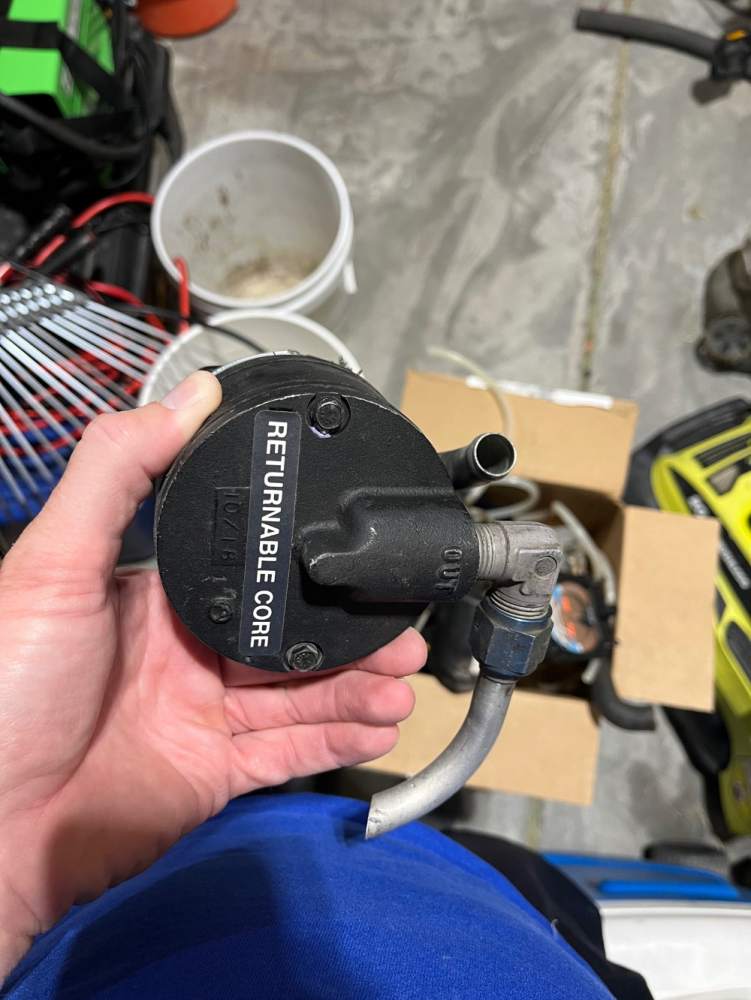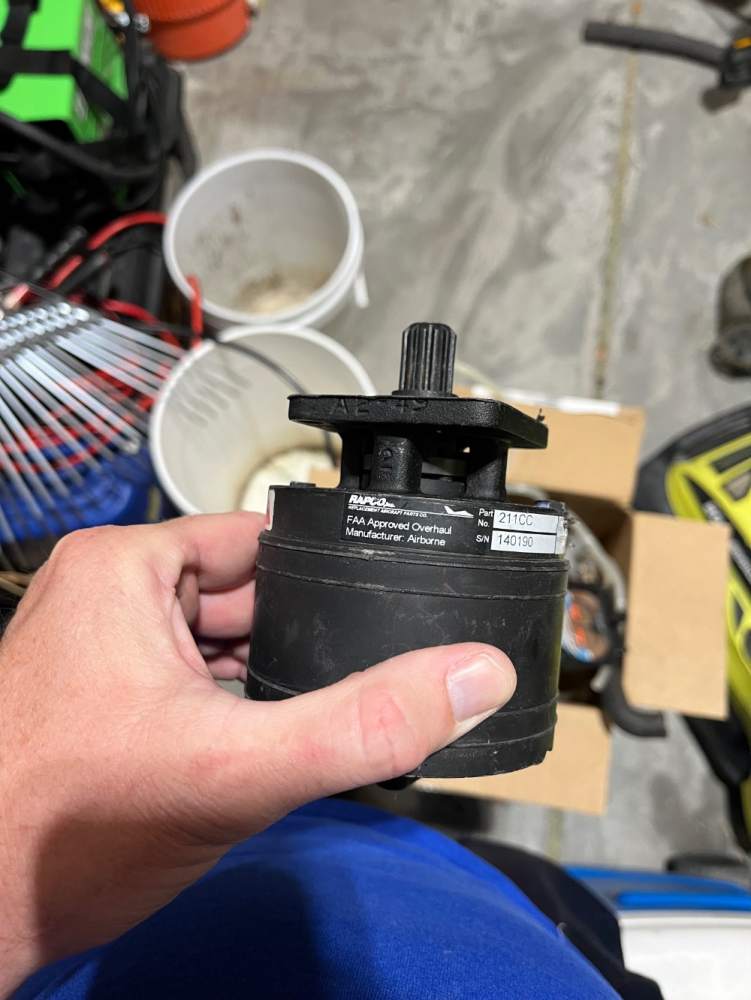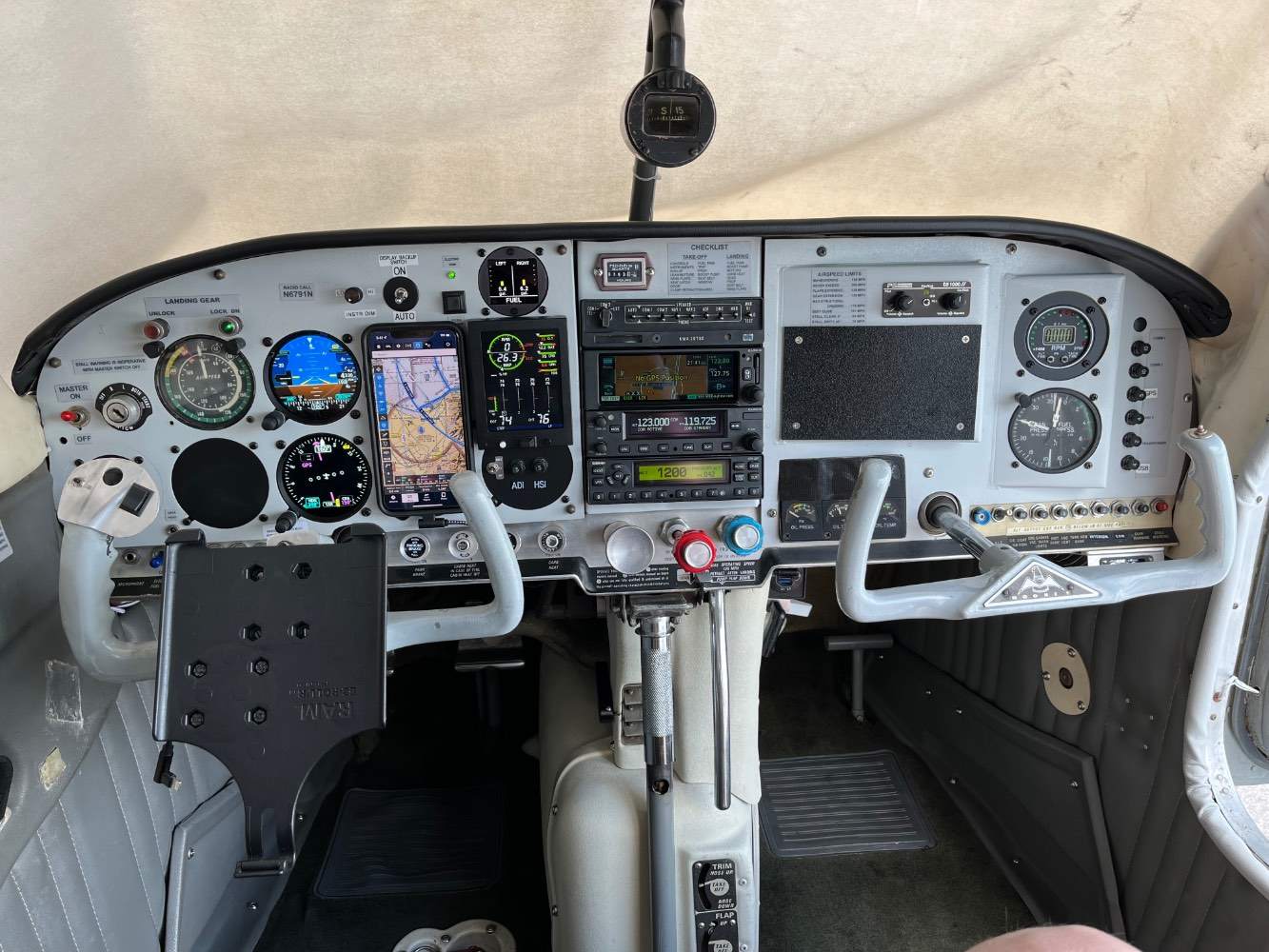-
Posts
907 -
Joined
-
Last visited
Content Type
Profiles
Forums
Blogs
Gallery
Downloads
Events
Store
Everything posted by Utah20Gflyer
-
If you want an inexpensive replacement I have a used rapco pump I pulled off my plane when I did the vacuum system delete. It probably has 350-400 hours on it but was working well when removed. I’d sell it for 100 bucks with shipping included. Message me if you are interested. Looks to be a counter clockwise unit.
-
You State that your battery is approved for E-K but my understanding is it isn’t approved for a G model which falls in that range. So it would be more accurate to say E-F,J-K. The G model has the battery forward of the firewall like the rest of the carbureted Mooneys. (A-D and G) Could you comment on when the approval may happen for the carbureted Mooneys and whether heat from the engine is the complicating issue? Thanks, I’m interested in increasing my UL next time I need a battery.
-
Here is what a previous owner did with the pilots yoke in my airplane. It’s just a piece made from aluminum plate.
-
I’d suggest starting at the reservoir and working your way down the system. My reservoir is above the rudder pedals and under the pilot side avionics access panel. Master cylinders are under the floor right next to the electric fuel pump, that’s always a good bet. Although it could be anywhere if you remove two belly panels that will expose the majority of the likely possibilities.
-
Are our aircraft batteries deep cycle or starting batteries? I was under the impression they were starting batteries. Seems to me the battery test people are talking about is abusive to a starting battery. I don’t know this for sure but I’ve heard that a starting battery will be damaged by complete discharges and repeated complete discharges will likely be fatal (5-6). When I was a tire and Battery tech at sears at 18 years old we tested starting batteries by putting a high amp load on them and watching the battery voltage. A good battery would drop in voltage slightly and then slowly drop. A bad battery would drop a lot in voltage immediately down to 9 or 10 volts. This test took 30 seconds to do. If I were to test my battery this is the type of test I would do. It approximates the use case for the battery and doesn’t abuse it. If you want any to regularly test amp hour capacity then I would recommend getting a Lithium Ion battery. They can be fully discharged 1000+ times without any appreciable effect.
-

M20F crash Carrizozo NM 8/2/24
Utah20Gflyer replied to Mooney in Oz's topic in Mooney Safety & Accident Discussion
CHTs would be super high at that fuel flow. One of the challenges of high DA takeoffs in an older Mooney like mine is a fuel flow that keeps engine temps reasonable also leaves a lot of potential power unused. Now, having said that even my plane with 20 less hp can take off with plenty of safety margin at that DA - if things are done correctly. The key is to keep the plane as light as possible (1 person, half tanks) You have to lean as much as possible (heat limited) and accept that CHTs are going to exceed 420+ degrees. We don’t have any details about what happened but Full fuel in an F would be a lot of extra weight. The one person, full fuel and a bunch of baggage could be excessive for those conditions. Full rich or excessively rich on takeoff would rob the engine of a lot of power could have been an issue. But we don’t know. Could the crash be solely caused by a down draft? Possibly, but I suspect it was only the last straw. I’m really glad the pilot was Ok! -
I think this is the key. As long as everything chosen compliments the rest it will look great. The key is staying away from close matches that don’t actually quite match. For example two light greys might not look good because they are close but not exact. But if you do a light grey and a medium grey from different suppliers it won’t look pieced together.
-

Wanted M20F Rudder servo bellows
Utah20Gflyer replied to Bobaran's topic in Avionics / Parts Classifieds
I have a complete set of servos I’d like to sell . Everything but the step servo looks to be in good condition. I’d sell the set for 200.00. I don’t want to split the set. Message me if you are interested. Thanks -
I’ve been having issues with my GI 275 updates as well. I might try to take my plane into the avionics shop next week to address a separate issue and will see if they have any resolution to the issue.
-
In my opinion this would fall under owner preventative maintenance because you are replacing a standardized part that requires no complex disassembly or reassembly. I’m going off my interpretation of the Coleal legal interpretation on the issue. Generally you are only removing 2 screws and one nut and then replacing them to reinstall the breaker. The operation is approximately as complex as installing a new battery which is explicitly allowed. If this seems like a stressful operation I would recommend having an A&P assist you with it, or maybe supervise you doing it yourself. You might ask the IA who does your annual what they would think of you replacing the breaker and logging it. This opinion is also just my own and also carries no weight.
-

Used autopilot options for m20F
Utah20Gflyer replied to kechmant's topic in Vintage Mooneys (pre-J models)
I have a complete set of vacuum servos with serviceable boots with the exception of the retractable step servo, that one works but leaks a little. If you want them send me a message and I’ll make you a deal on them. -

Used autopilot options for m20F
Utah20Gflyer replied to kechmant's topic in Vintage Mooneys (pre-J models)
An STC is specific to a single airplane. So you can’t reuse the STC you have to get a new one from the company. My understanding is STEC wants 3k? to reissue an STC. Once you pay for the STC, the parts and the labor you are going to be approximately at the cost of the Aerocruze. The only auto pilot I think you could do cheaper would be the original Mooney PC system. Personally I wouldn’t want to put in the effort to do a new install on a system that old but it is an option. -
I’m going to admit I’ve been looking at Cessna turbo 206s lately. I’m sure I won’t enjoy flying one as much as my Mooney but I have a lot of kids and for family adventures it has a lot of utility. In particular the 6 seats, incredible useful load and short/rougher field capability.
-
So coincidentally my yoke started having a little bit of play in it again so I decided to try removing my lightly loctited set screw and then re torque it. It was fairly stiff coming out which made we worry just a little but I got it out fine, cleaned it up and replaced it, but this time didn’t use loctite. I’m going to see how long it takes before it comes loose again. If it reoccurs quickly I’ll probably reinstall with loctite again. Once again using the minimum amount possible.
-

Annual Maybes - To do or not to do?
Utah20Gflyer replied to Lax291's topic in Modern Mooney Discussion
In regards to oil air separators being controversial. It seems like if you have an oil/air separator and your oil analysis comes back fine then I can’t see a rational reason to be against them. Personally I want to see objective data indicating there is a problem before I go along with someone’s hypothesis and oil analysis will definitively demonstrate whether there is a problem. -

External camera mounts, '64 E model
Utah20Gflyer replied to ElisiumNate's topic in Vintage Mooneys (pre-J models)
I concur with the others, choose an inspection panel that isn’t associated with the fuel tank. -
I’m not sure why everyone is so upset about the government being interested in your butt hole. It just shows they care.
-
One of the biggest questions is how much recent flying has it been doing and what kind of maintenance has it received. You want to buy a plane that has been flying a lot and has been receiving regular maintenance. If you can actually go see the plane in person you want to try to figure out if everything works. If you find lots of things don’t work on a cursory inspection you can be sure you will find a lot more things after you buy it.
-
Mine is on a data plate on the passenger side just behind the cowling.
-

Mooney grounded in Foley, AL
Utah20Gflyer replied to 00-Negative's topic in Vintage Mooneys (pre-J models)
You might check e bay and some other used part sources for that down tube. -
I think the most important use is in the case of an over voltage condition you can shut down the charging system to prevent damage to your battery and possibly other things.
-

67 F GPS navcom advice please
Utah20Gflyer replied to Bobaran's topic in Vintage Mooneys (pre-J models)
Yeah, your plane probably had two King KX 170 radios and then someone replaced one of them with the TKM MX 170. This was a popular upgrade because you slide the King out and slide the TKM in and you’re done. Kind of like upgrading a Garmin 430 with the Avidyne 440. With no install it’s very appealing. Only downside is the TKM radios have a rep for not being very durable. When I sent mine in to get repaired they said it was not repairable and offered to sell me a new one for 2500 or 3000. I ended up putting in the Garmin 255 because I wanted a modern radio that had an internal ILS receiver and was concerned about how long the new TKM would last. I thought that might be a KI 214 CDI but wasn’t sure. If that’s the case then it gets the localizer/VOR signal from the radio and the ILS receiver is inside the KI 214. I also had a KI 214 in my plane when I bought it and it was bad. I also understand from my research that they are not repairable. KI 214s like the TKMs seem to have lots of problems. If you swap the radios yourself be careful of the locking lug that you have to loosen to remove it. If you turn it the wrong way too hard you can actually damage the radio. If you need to replace the king radio I have a kx 175b I’d sell you for 250, I’ll throw the ILS receiver in for free. The 175 is the certified version of the 170, they are interchangeable. -

67 F GPS navcom advice please
Utah20Gflyer replied to Bobaran's topic in Vintage Mooneys (pre-J models)
Does the other nav radio and CDI work correctly? The two radios you have are slide in replacements for each other which is helpful because if the other radio/CDI combo works you can swap the radios and determine if it’s the radio or CDI that is bad. You need an ILS receiver if you want ILS capability but you don’t need it for IFR. In particular if you get a WAAS GPS which will allow you to do LPV approaches. You used to need ILS capability to satisfy the precision approach requirement of the Instrument checkride but you can use LPV approaches now. You also need two non precision approaches which could be RNAV, VOR or Localizer. The GPS will provide DME functionality so you wouldn’t need the old INOP one. Personally I like having the option of ILS, but it’s not A must. Ultimately the decision on what goes into a IFR panel is determined by what you are willing to fly into instrument conditions with. Technically you could fly IFR in a plane with a single nav radio and CDI as long as you had your pitot static, Transponder and VOR check current. Few people would want to do that though. You might consider taking a couple flights with a CFII in your airplane and a few different rental planes and see what you think you need after comparing them. -

67 F GPS navcom advice please
Utah20Gflyer replied to Bobaran's topic in Vintage Mooneys (pre-J models)
I think the minimum would be a 355 gps com and a G5 HSI, you wouldn’t have ILS capability but would still have all the GPS stuff plus VOR and LOC approaches. Have you diagnosed the ILS issue? Neither of those radios have ILS receivers in them so either you have a stand alone ILS receiver box or it’s incorporated into your CDI. I have a stand alone ILS receiver I’ll sell you super cheap if that will help you get back that capability. If you get a GI 275 HSI they have better compatibility with older radios and you could have everything going into that. Before I had the 255 installed I had a king kx175b feeding it nav information. Something to consider. Your installer may be able to do the same thing with a g5 but not sure about that. I’ve been told they only work with the more modern digital radios?







